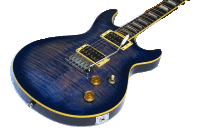Guitar Strumming Patterns
Learning open chords is a good starting point for playing accompaniment to many songs. By mastering a number of guitar strumming patterns from this lesson, you'll be able to get your rhythm guitar skills to the next level and turn even simple chord progressions into great-sounding accompaniments.
You don't necessarily need to learn all of them; just pick the ones you like and use them in your playing.
But remember:It's important to strum or pick the strings in a rhythmic manner, maintaining consistent strumming across the different chords you play. You can tap your foot to keep a pulse that supports the rhythm, or use a metronome or drum tracks for this.
To create the beat with your foot, use the following counting:
- 1 – the foot knocks the floor. And - the foot lifts up,
- 2 – the foot knocks the floor. And - the foot lifts up,
- 3 – the foot knocks the floor. And - the foot lifts up,
- 4 – the foot knocks the floor. And - the foot lifts up

After the "4 - And", go back to the "1 - And - 2 - And", and so on...

The pattern sounds better when played a bit looser on the strum up, and the lower string is missing the stroking.




To perform the muted strums, place the edge of your strumming hand on the strings near the guitar bridge, so the strings become muffled, and while remaining in this position, strum the chord in the direction indicated by the white arrows.
It's in some way similar to the palm mute technique, but the muted strumming is perceived more as a percussive effect. You don't have to strum all the strings for it.









This strumming pattern looks straightforward in the diagram, but be aware of the dynamics: accent the strums at the black arrows a bit and play them looser at the gray ones.
More Advanced Patterns
In the wider strumming diagrams, I included patterns that are two bars in length, which is why the count is repeated twice.

Note that some strums here are really short.


To remember this pattern more easily, identify the sequence:
- 2 regular strums, followed by 1 muted strum - repeat this 5 times.
- After the 5th repetition, add 1 extra muted strum (the pattern's end).
Notice that the direction in which you strum alternates throughout the entire piece.


Although the pattern looks simple, it might be challenging for beginner guitar players.
Pay attention: there are three strums per beat, and each of them should be played with the same amount of time.
This rhythmic formation is called a triplet.

Related Articles
